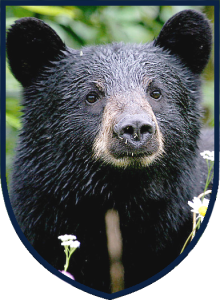Current work
Addressing bear-human conflict
Humans and black bears (Ursus americanus) value similar types of habitat, such as valley bottoms, forested areas, and riparian zones. As human settlements grow and spread into high-quality bear habitat, contact between the two species increases. Unfortunately, interactions between bears and humans can have costly or deadly consequences for either or both parties.
- Humans may be harmed or killed by a startled or aggressive bear
- Problem bears can damage crops or human property
- Bears that become habituated to humans or urban areas are often destroyed or relocated
Strategies to deal with bears that have become habituated to humans or urban areas include deterrents, relocation, and destruction of the animal. However, these strategies are reactive; it would be better to use and develop strategies of bear management that aim to reduce the chance that a bear would become habituated in the first place. Such a strategy should lower the number of bear-human conflicts and therefore limit property damage, reduce the number of humans injured or killed by problem bears, and reduce the number of bears that need to be destroyed.
Evaluating different management strategies
Experimentally comparing the effectiveness of different wildlife management tactics is problematic when it comes to living animals, and this is especially true with large, long-lived, charismatic mammals
- Bears are large, dangerous predators that require special handling and care
- A long-term, large-scale study would be needed due to bears’ long lives and extensive home ranges
- Experiments dealing with wild bears have ethical considerations
- Replication would be difficult due to variations in the configurations of natural and urban landscapes
- Most importantly, experimentally testing different strategies is likely to create problem bears
Agent-based or individual-based modelling provides a spatial environment in which the problems with experimentally testing bear management strategies do not apply. An agent-based model is cost-effective, can run hundreds or thousands of simulations of a given set of parameters, and avoids ethical issues that come with ecological experimentation.
Model background and summary
The model that I’m working with was developed over several years by researchers at the University of British Columbia, Okanagan Campus. The model was originally implemented as a mathematical model before being converted to an agent-based model in Matlab, then translated into the current Netlogo version of the model.
In the model, a virtual bear moves around a simulated landscape, moving to the areas nearby with high amounts of food available. If the model bear enters an urban area, it may enter into conflict with humans. If humans deter the bear, it will flee, but if the bear is undeterred it risks becoming a conflict bear. The model thus allows for the assessment of the likelihood of creating a problem bear with a given set of model parameters.
Bear management strategies to model
Drift fencing
- Drift fences, long segments of fences, would be implemented in areas of high bear activity or traffic
- Aim to guide bears around or away from urban areas
- Can be used in conjunction with complete fencing of bear attractants, such as the dump
Conservation officer(s)
- Evaluate the effect of a conservation officer in the urban landscape
- Increase the probability of deterrence for a given urban cell/area
- May be modelled by an agent that moves around the landscape independently, or by a timed event that affects any urban area the model bear enters
Vegetation modification
- Assess the effect of changing vegetation quality/type near urban areas
- Intended to reduce the bear’s perception of food-value in the natural landscape
- Could also increase the food value in corridors that lead bears around or away from urban areas
Overarching goal
Eventually I hope that the model will be able to inform communities regarding their optimal bear-management strategy or program. The model will take in GIS layers of landscape data, as well as bear movement data, and output scenarios that most efficiently reduce the number of conflict bears.
